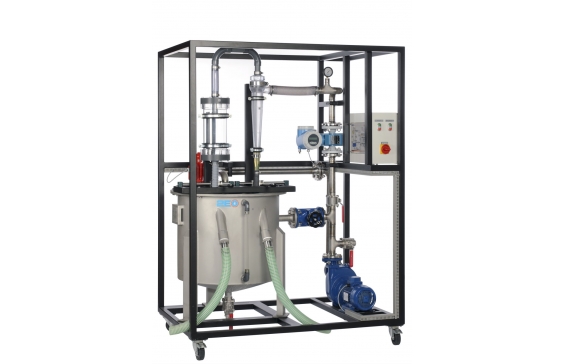CE 225 Hydrocyclone

Hydrocyclones can be used to separate solids suspended in liquids. In CE 225, the suspension is prepared in a tank. A pump delivers the suspension into the tangential inlet of the cyclone. In the cyclone a downward primary vortex is created. The downward taper causes the vortex to reverse. In the middle it moves as a secondary vortex back up towards the immersion tube, where the suspension emerges from the cyclone, having lost the coarse material in it. Inside the cyclone an air core is formed. The centrifugal forces cause the coarser solid particles in the primary vortex to be enriched. They are discharged with the bottom flow at the apex nozzle. It is mainly the fine material that is discharged from the top.
The flow rate in the inlet is adjusted by a valve in a bypass and measured with an electromagnetic flow meter. Sampling points are installed at the bottom and top flow. The flow rates in them can be determined by means of a bucket and a stopwatch. To determine the solid concentration, a balance and a drying chamber are recommended. Using a suitable analysis device (such as a diffraction spectrometer), a separation function can be produced and the separation size determined. Quartz powder and diatomite are recommended for use as the solid.
The trainer was developed in cooperation with the Department of Mechanical Process Engineering at Anhalt University of Applied Sciences.
- solid separation with a hydrocyclone
- optimum observation of processes through transparent materials
- practical experiments on a laboratory scale
Cyclone
- height: 710mm
- diameter: 114mm
- immersion tube diameter: 40mm
Stirred tank
- capacity: 200L
- material: stainless steel
Top flow tank
- capacity: 5L
- material: PMMA
Pump
- max. flow rate: 400L/min
- max. head: 30m
Measuring ranges
pressure: 0…4bar
flow rate: 0…200L/min
400V, 50Hz, 3 phases
400V, 60Hz, 3 phases
230V, 60Hz, 3 phases
UL/CSA optional
- solid separation from liquids with a hydrocyclone
- hydrocyclone with tangential inlet
- stirred tank for preparation of suspensions
- centrifugal pump to deliver the suspension
- adjustment of flow rate by valve in bypass
- electromagnetic flow meter at inlet
- sampling points on the top and bottom flow to determine the flow rates and solid concentrations
- manometer to determine the pressure loss at the cyclone
- fundamental principle and the method of operation of a hydrocyclone
- solid mass flow rate in feed, top and bottom flow
- liquid mass flow rate in feed, top and bottom flow
- characteristic values for sharpness of separation
- pressure loss at the cyclone dependent on the feed flow rate
- influence of solids density on characteristic values and pressure loss

